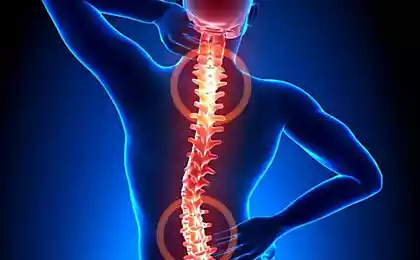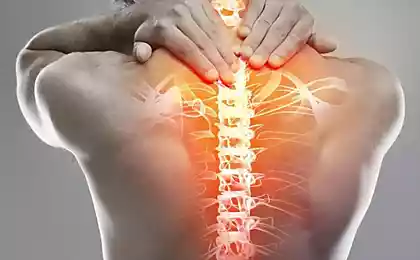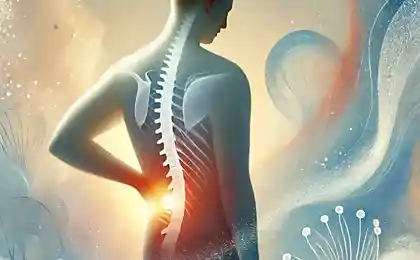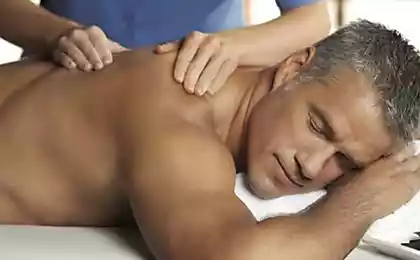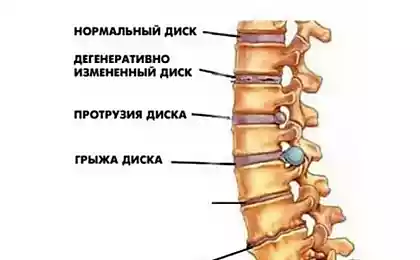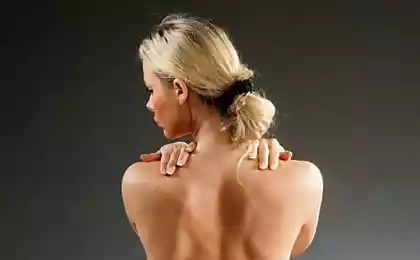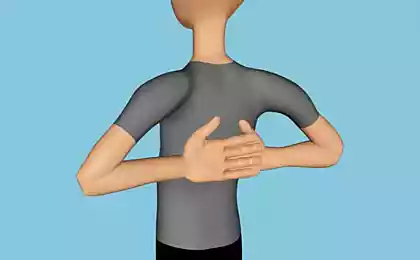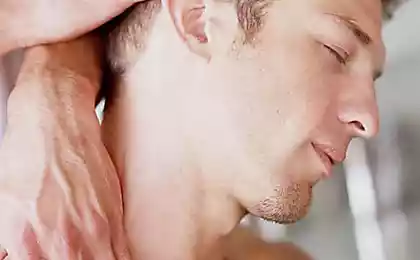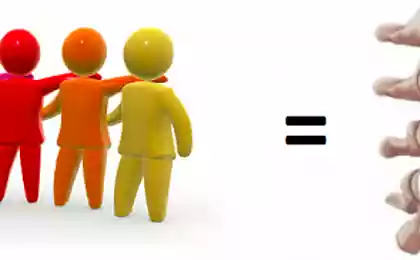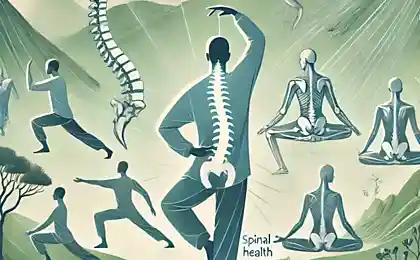589
The best exercises for the health of Your spine
Position training structural perfection of the body using the wall as a support Using the wall as support and a kind of a template, you can feel the point where your spine will elongate, structurally balanced position.
Since for this exercise you need almost any flat vertical surface against which one could lean, this position you can use almost everywhere as a recovery exercise after work in the poses.
This position will provide a wonderful way to relieve the spinal column and relieve discomfort from overexertion of the back for those who suffer from diseases of the spine (especially the sciatica and sciatica).
Sixty eight million eight hundred forty eight thousand six hundred seventy five
. The lower part of the body. Will prelolitas back to the wall surface; a heel located at a distance of about 30-45 cm from the wall. Slightly bent knees, bend your pelvis back so that his lower spine was pressed firmly against the wall without feeling any discomfort.
If you have any discomfort, you need to master this movement of the pelvis gradually. The upper third of the thighs thus will be perpendicular to the surface of the ground or slightly deflected in the direction of the wall. Feel what is comfortable for you to stand, clinging to the wall that way.
b. Feet. Firmly pressing the pads of both big toes to the floor, spread the toes out to the sides, simultaneously relaxing the foot. Then distribute evenly body weight on three points located on the soles of the feet: the thumb, fourth and fifth toes and mid heel.
The toes should be relaxed, not much resting on the floor; the other fingers should be pointing right. Keep this position the feet, even if you feel that for you it is unusual.
Try to use this situation of the feet in everyday life when walking, any exercise, etc.
Twenty eight million eight hundred sixty nine thousand five hundred seventy seven
V. The head, neck and upper spine. Push a greater part of the upper spine more flat to the wall surface; start with pressing the coccyx, keeping the remainder of the spine rounded forward so that at first he did not touch the wall.
Then start to "roll" the spine up the wall, vertebrae by vertebrae until, until it reaches the utmost degree of bending.
Head hold as if one force pushes it slightly back in the upper lip, and the other power lifts his head for the cover of the skull.
Try not to exceed the angle of the head due to excessive pulling of the chin to the collarbone. With some back of the head may not touch the surface of the wall (Fig. 4-4).
Fourteen million two hundred fifty five thousand nine hundred ten
g. Shoulder girdle. Shoulders down from the ears, expand them wider to the sides (Fig. 4-5; see also described in this Chapter exercise for developing the shoulders).
D. Shoulders, forearms.There are several possible positions of the forearm:
1. Put your hands down along the sides so that the palms face the body. This hand position is the most natural and suitable to perform different exercises in the midst of people for example at work when you don't want someone watching you from the side.
2. Taking the position (1) as the source, pull your elbows back so that they barely touched the wall; it should not touch the wall of the lower part of the arm or back to move the shoulders.
This position allows you to reach the proper structural connections of the bones of the shoulder girdle. As the abduction of the elbows back shoulders, of course, also slightly moves in this direction, not specifically testing efforts.
3. Starting position — his back to the wall. Gradually pull your left shoulder away from the wall, it will not touch only the inner edge of the condyle of the left humerus.
Then slowly restore the full contact of the left shoulder to the wall. Do the same with right shoulder.
After the exercise, put the hands in position (1) or (2). This exercise contributes to a significant stretching of both the shoulder bones, at the same time resulting in an increase in the width of the shoulders, upper back and expanding the chest. In addition, it is a good preparatory exercise before executing the elements of the complex Iron Shirts that require significant power blades.Should refuse to implement the provisions of (2) and (3) if they lead to significant tension in the shoulder girdle.
E. Stretching of the lumbosacral spine. To strongly pull the lower section of the spine, slightly bend your knees and slip your back below on the wall surface.
Then, while continuing to firmly press the tailbone to the wall, start slowly straighten the legs. To enhance the process of stretching place your hands on your hips and press down, continuing to straighten legs to starting position.
This exercise allows you to significantly extend the lumbosacral spine, however, it should be performed only when a tight compression of the lower spine to the wall does not cause discomfort.
The effectiveness of the exercise can be improved by performing it in the emphasis on the wall with a rough surface. Additional stretching of the spine can be particularly useful for people suffering from pain in the lumbosacral or sciatica.
well. Breathing in the process of weggegeven spine. Seventeen million six hundred sixteen thousand ninety three
The situation in focus on the wall for training the structural alignment of the body helps to unload and straighten the spine. The positive effect did not require the execution of complex breathing exercises.
After all, the purpose of this provision is not a straight spine, and the ability to straighten it; this wall allows you to feel the moment when the spine is in the most aligned and straightened position.
The human spine having the perfect structure of the body, naturally elongates the process of the breathing cycle. It mostly happens at the time of filling the chest with air during inspiration, when the ribs of the chest rise up and parted to the side, forcing the edge of individual vertebrae.
Thus, using the technique of deep thoracic breathing in the above-described position, and also when Hanging on a Door allows you to establish a natural connection between the breathing process and structural trim parts and organs of the body (Fig. 4-6).
Reaching stretching of the vertebral ‘column in the process of exercise, you will be able to stretch it without resorting to special techniques, due to regular abdominal breathing.
An integral part of the normal functioning of the structural mechanism of the body is the opening of the spine to the passage of energy in the process of breathing: this allows you to significantly increase the supply of organs Central nervous system, blood, Chi and cerebrospinal fluid.
Technical skills of breathing in the process of stretching of the spine. Breath.To enhance the effect from the implementation of a structural training with an emphasis on wall and use breathing exercises, you must first do a complete exhalation. Then inhale slowly and deeply through the nose, directing the energy of the breath in the chest area. Anterior abdominal wall of the abdomen should be slightly drawn.
Performing a breath, observe visually and try to feel the sky, the spine. With a relaxed state of the body that happens automatically. Don't try to force your own efforts.
Catching the moment of lengthening of the spine, in the future focus on the development of this feeling, internally watching the process of elongating the breath wave, appearing in the coccyx, gradually rises up.
b. Exhale. While exhaling, try to feel that you are not reduced and continue to grow up. You will feel United in a single structure, the back muscles take over initiated by the energy of the breath stretching the spine.
In fact, lengthening the spine upwards when you exhale significantly less than during inspiration; however, the elongation at exhale is the result only of the additional support measures from the side of the body to prevent collapse of the thorax. This wave of support, occurs when exhalation starts in the head, gradually spreading downwards.
V. Tightening of the muscles of the anterior abdominal wall. In the case of a structural blockade of the thorax when you inhale a full breast, it may be necessary tightening of the muscles of the anterior abdominal wall. Otherwise, when you inhale the chest will remain virtually pressurewise, while the lower part of the abdomen is much swollen.
Over time, you will need to make less effort to maintain the stomach to pull up the position when you inhale the chest; in the end, you will be able to breathe with the chest, without the use of conscious contraction of the muscles of the anterior abdominal wall.
G. Daily breath. This method of thoracic breathing is a kind of exercise designed to correct structural blockade of the thorax and the maximum traction of the spine. After completing the exercises to develop breath, try to turn off your attention from how you breathe.
Let the process of breathing happens naturally. Natural breathing is done through the lower and middle abdomen and the chest area is included only if the increased physical activity associated with the need to use full lung capacity. It is not recommended to use in daily life full respiratory cycle, as it may lead to stagnant energy phenomena in the chest and head.
Structural alignment of the organs of the head and neck as the basis for the extension of the vertebral column and General structure of the vertical position of the human body To achieve stretching of the spine with breathing is possible only when there remains a certain head position: imagine that you slightly push into the upper lip, at the same time lifting the lid of the skull without the stress of the neck (Fig. 4-7).
Seventy two million five hundred twenty nine thousand four hundred thirty one
Already a slight displacement of the chin upward and forward will lead to structural disorders of the neck, causing total structural distortion of the upper body. While the cervical curve of the spine is clearly excessive, making it impossible deep and free breathing because the lumen of the breathing tube in the throat is almost closed.
But this situation of the head and neck is typical of most people, so rare to find someone who is not a chronic displacement of the vertebrae of the cervical.
The above position of the head (when she raised the lid of the skull and moved a bit ago) is the key for most exercises.
In addition, this position is essential for correct posture and free breathing. Proper structural alignment of the organs of the head and neck allows you to provide a physiologically favorable relationship between the head and the other organs of the body.
In turn, this allows you to monitor the status of the overall structure of the body. One of the canons highest stages of meditation Taoist system of healing known as "Small Enlightenment of the Kan and Li", teaches us to exercise control over one's own body with the inner eye.
Thus, conscious structural alignment of the organs of the head and neck is the basis of the interest in structural optimization of all body organs. Compare: in the practice sessions of Hatha Yoga, elongation of the cervical spine resulting from the structural alignment of the complex head-neck, is called the "Root of Diligence" or "Reasonable Roots Approach."
At least a little attention to maintaining the structural balance of the head and neck need even after balanced structural alignment becomes easy and natural.
After all, the single most important factor in the proper vertical position of the body is slight pulling the head up with a slight deviation ago. Thus the actual elongation of the cervical vertebrae is extremely low. Almost imperceptible is the head tilt back.
And yet these two elements provide education structure right chest – upper back – spine. The reason is that the head and cervical spine are sort of the crown of the spine, which we seek to draw out; so the structural integration of bodies and body parts is impossible without this subtle, but significant element.
In addition, you must have a General understanding of this very common phenomenon of dysplasia of the cervical vertebrae. Bringing the body into a state of structural alignment, pull the chin up and forward, thus removing it from the General equilibrium structure.
You will immediately feel reduced occipital muscles of the neck, closes the lumen of the larynx, the chest will become concave due to the omission of the sternal bone; the shoulders are rounded forward due to the formation of excessive bending of the cervical-thoracic spine, the breath will become labored and viagenie the vertebral column would be impossible.
Then do the breathing exercise for Stretching the Spine, which requires the restoration of the right of landing heads, and you will immediately feel full of energy openness to all organs of your body.
There is a close relationship between the permanent control of the optimal structure of the body, the correct vertical position of the body and free, newselena position of the head and neck. This relationship is particularly evident during exercise complex Iron Shirts.
The desire to maintain the correct structural position of the head and neck in combination with careful attention to the General structure of the body is an expression of the independent will to perfection.
In turn, the optimization of the structure of his own body in full relaxation the most favorable impact on the formation and strengthening of the will.
P. S. And remember, only by changing their consumption — together we change the world! ©
Join us in Facebook , Vkontakte, Odnoklassniki
Source: qiclub.ru/mantak-chia-vypravlyaem-strukturu-tela-po-stene.html
Since for this exercise you need almost any flat vertical surface against which one could lean, this position you can use almost everywhere as a recovery exercise after work in the poses.
This position will provide a wonderful way to relieve the spinal column and relieve discomfort from overexertion of the back for those who suffer from diseases of the spine (especially the sciatica and sciatica).
Sixty eight million eight hundred forty eight thousand six hundred seventy five
. The lower part of the body. Will prelolitas back to the wall surface; a heel located at a distance of about 30-45 cm from the wall. Slightly bent knees, bend your pelvis back so that his lower spine was pressed firmly against the wall without feeling any discomfort.
If you have any discomfort, you need to master this movement of the pelvis gradually. The upper third of the thighs thus will be perpendicular to the surface of the ground or slightly deflected in the direction of the wall. Feel what is comfortable for you to stand, clinging to the wall that way.
b. Feet. Firmly pressing the pads of both big toes to the floor, spread the toes out to the sides, simultaneously relaxing the foot. Then distribute evenly body weight on three points located on the soles of the feet: the thumb, fourth and fifth toes and mid heel.
The toes should be relaxed, not much resting on the floor; the other fingers should be pointing right. Keep this position the feet, even if you feel that for you it is unusual.
Try to use this situation of the feet in everyday life when walking, any exercise, etc.
Twenty eight million eight hundred sixty nine thousand five hundred seventy seven
V. The head, neck and upper spine. Push a greater part of the upper spine more flat to the wall surface; start with pressing the coccyx, keeping the remainder of the spine rounded forward so that at first he did not touch the wall.
Then start to "roll" the spine up the wall, vertebrae by vertebrae until, until it reaches the utmost degree of bending.
Head hold as if one force pushes it slightly back in the upper lip, and the other power lifts his head for the cover of the skull.
Try not to exceed the angle of the head due to excessive pulling of the chin to the collarbone. With some back of the head may not touch the surface of the wall (Fig. 4-4).
Fourteen million two hundred fifty five thousand nine hundred ten
g. Shoulder girdle. Shoulders down from the ears, expand them wider to the sides (Fig. 4-5; see also described in this Chapter exercise for developing the shoulders).
D. Shoulders, forearms.There are several possible positions of the forearm:
1. Put your hands down along the sides so that the palms face the body. This hand position is the most natural and suitable to perform different exercises in the midst of people for example at work when you don't want someone watching you from the side.
2. Taking the position (1) as the source, pull your elbows back so that they barely touched the wall; it should not touch the wall of the lower part of the arm or back to move the shoulders.
This position allows you to reach the proper structural connections of the bones of the shoulder girdle. As the abduction of the elbows back shoulders, of course, also slightly moves in this direction, not specifically testing efforts.
3. Starting position — his back to the wall. Gradually pull your left shoulder away from the wall, it will not touch only the inner edge of the condyle of the left humerus.
Then slowly restore the full contact of the left shoulder to the wall. Do the same with right shoulder.
After the exercise, put the hands in position (1) or (2). This exercise contributes to a significant stretching of both the shoulder bones, at the same time resulting in an increase in the width of the shoulders, upper back and expanding the chest. In addition, it is a good preparatory exercise before executing the elements of the complex Iron Shirts that require significant power blades.Should refuse to implement the provisions of (2) and (3) if they lead to significant tension in the shoulder girdle.
E. Stretching of the lumbosacral spine. To strongly pull the lower section of the spine, slightly bend your knees and slip your back below on the wall surface.
Then, while continuing to firmly press the tailbone to the wall, start slowly straighten the legs. To enhance the process of stretching place your hands on your hips and press down, continuing to straighten legs to starting position.
This exercise allows you to significantly extend the lumbosacral spine, however, it should be performed only when a tight compression of the lower spine to the wall does not cause discomfort.
The effectiveness of the exercise can be improved by performing it in the emphasis on the wall with a rough surface. Additional stretching of the spine can be particularly useful for people suffering from pain in the lumbosacral or sciatica.
well. Breathing in the process of weggegeven spine. Seventeen million six hundred sixteen thousand ninety three
The situation in focus on the wall for training the structural alignment of the body helps to unload and straighten the spine. The positive effect did not require the execution of complex breathing exercises.
After all, the purpose of this provision is not a straight spine, and the ability to straighten it; this wall allows you to feel the moment when the spine is in the most aligned and straightened position.
The human spine having the perfect structure of the body, naturally elongates the process of the breathing cycle. It mostly happens at the time of filling the chest with air during inspiration, when the ribs of the chest rise up and parted to the side, forcing the edge of individual vertebrae.
Thus, using the technique of deep thoracic breathing in the above-described position, and also when Hanging on a Door allows you to establish a natural connection between the breathing process and structural trim parts and organs of the body (Fig. 4-6).
Reaching stretching of the vertebral ‘column in the process of exercise, you will be able to stretch it without resorting to special techniques, due to regular abdominal breathing.
An integral part of the normal functioning of the structural mechanism of the body is the opening of the spine to the passage of energy in the process of breathing: this allows you to significantly increase the supply of organs Central nervous system, blood, Chi and cerebrospinal fluid.
Technical skills of breathing in the process of stretching of the spine. Breath.To enhance the effect from the implementation of a structural training with an emphasis on wall and use breathing exercises, you must first do a complete exhalation. Then inhale slowly and deeply through the nose, directing the energy of the breath in the chest area. Anterior abdominal wall of the abdomen should be slightly drawn.
Performing a breath, observe visually and try to feel the sky, the spine. With a relaxed state of the body that happens automatically. Don't try to force your own efforts.
Catching the moment of lengthening of the spine, in the future focus on the development of this feeling, internally watching the process of elongating the breath wave, appearing in the coccyx, gradually rises up.
b. Exhale. While exhaling, try to feel that you are not reduced and continue to grow up. You will feel United in a single structure, the back muscles take over initiated by the energy of the breath stretching the spine.
In fact, lengthening the spine upwards when you exhale significantly less than during inspiration; however, the elongation at exhale is the result only of the additional support measures from the side of the body to prevent collapse of the thorax. This wave of support, occurs when exhalation starts in the head, gradually spreading downwards.
V. Tightening of the muscles of the anterior abdominal wall. In the case of a structural blockade of the thorax when you inhale a full breast, it may be necessary tightening of the muscles of the anterior abdominal wall. Otherwise, when you inhale the chest will remain virtually pressurewise, while the lower part of the abdomen is much swollen.
Over time, you will need to make less effort to maintain the stomach to pull up the position when you inhale the chest; in the end, you will be able to breathe with the chest, without the use of conscious contraction of the muscles of the anterior abdominal wall.
G. Daily breath. This method of thoracic breathing is a kind of exercise designed to correct structural blockade of the thorax and the maximum traction of the spine. After completing the exercises to develop breath, try to turn off your attention from how you breathe.
Let the process of breathing happens naturally. Natural breathing is done through the lower and middle abdomen and the chest area is included only if the increased physical activity associated with the need to use full lung capacity. It is not recommended to use in daily life full respiratory cycle, as it may lead to stagnant energy phenomena in the chest and head.
Structural alignment of the organs of the head and neck as the basis for the extension of the vertebral column and General structure of the vertical position of the human body To achieve stretching of the spine with breathing is possible only when there remains a certain head position: imagine that you slightly push into the upper lip, at the same time lifting the lid of the skull without the stress of the neck (Fig. 4-7).
Seventy two million five hundred twenty nine thousand four hundred thirty one
Already a slight displacement of the chin upward and forward will lead to structural disorders of the neck, causing total structural distortion of the upper body. While the cervical curve of the spine is clearly excessive, making it impossible deep and free breathing because the lumen of the breathing tube in the throat is almost closed.
But this situation of the head and neck is typical of most people, so rare to find someone who is not a chronic displacement of the vertebrae of the cervical.
The above position of the head (when she raised the lid of the skull and moved a bit ago) is the key for most exercises.
In addition, this position is essential for correct posture and free breathing. Proper structural alignment of the organs of the head and neck allows you to provide a physiologically favorable relationship between the head and the other organs of the body.
In turn, this allows you to monitor the status of the overall structure of the body. One of the canons highest stages of meditation Taoist system of healing known as "Small Enlightenment of the Kan and Li", teaches us to exercise control over one's own body with the inner eye.
Thus, conscious structural alignment of the organs of the head and neck is the basis of the interest in structural optimization of all body organs. Compare: in the practice sessions of Hatha Yoga, elongation of the cervical spine resulting from the structural alignment of the complex head-neck, is called the "Root of Diligence" or "Reasonable Roots Approach."
At least a little attention to maintaining the structural balance of the head and neck need even after balanced structural alignment becomes easy and natural.
After all, the single most important factor in the proper vertical position of the body is slight pulling the head up with a slight deviation ago. Thus the actual elongation of the cervical vertebrae is extremely low. Almost imperceptible is the head tilt back.
And yet these two elements provide education structure right chest – upper back – spine. The reason is that the head and cervical spine are sort of the crown of the spine, which we seek to draw out; so the structural integration of bodies and body parts is impossible without this subtle, but significant element.
In addition, you must have a General understanding of this very common phenomenon of dysplasia of the cervical vertebrae. Bringing the body into a state of structural alignment, pull the chin up and forward, thus removing it from the General equilibrium structure.
You will immediately feel reduced occipital muscles of the neck, closes the lumen of the larynx, the chest will become concave due to the omission of the sternal bone; the shoulders are rounded forward due to the formation of excessive bending of the cervical-thoracic spine, the breath will become labored and viagenie the vertebral column would be impossible.
Then do the breathing exercise for Stretching the Spine, which requires the restoration of the right of landing heads, and you will immediately feel full of energy openness to all organs of your body.
There is a close relationship between the permanent control of the optimal structure of the body, the correct vertical position of the body and free, newselena position of the head and neck. This relationship is particularly evident during exercise complex Iron Shirts.
The desire to maintain the correct structural position of the head and neck in combination with careful attention to the General structure of the body is an expression of the independent will to perfection.
In turn, the optimization of the structure of his own body in full relaxation the most favorable impact on the formation and strengthening of the will.
P. S. And remember, only by changing their consumption — together we change the world! ©
Join us in Facebook , Vkontakte, Odnoklassniki
Source: qiclub.ru/mantak-chia-vypravlyaem-strukturu-tela-po-stene.html


